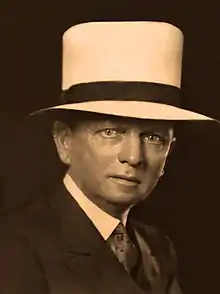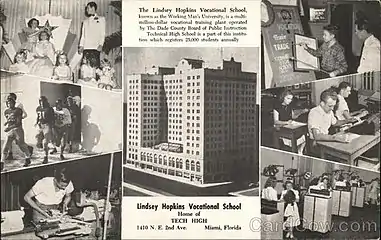Lindsey Hopkins Sr.
Lindsey Hopkins Sr. (April 22, 1879 - August 14, 1937) was an American businessman and philanthropist. He was both a major stockholder and a director of the Coca-Cola Company. In addition, he was a director at The Sperry Corp., North American Aviation (of which Eastern Airlines was a subsidiary), the Reynolds Metal Company, and several banks and insurance companies.[1] His Metropolitan Miami real estate included business and hotel properties in Miami, Coral Gables and Miami Beach.
Lindsey Hopkins Sr. | |
|---|---|
 | |
| Born | April 22, 1879 |
| Died | August 14, 1937 (aged 58) |
| Education | University of North Carolina |
| Known for | Coca-Cola Banking Investing Coral Gables |
| Spouse(s) | Leonora J. Balsley |
| Parent(s) | Jonathan Hopkins and Minerva Jones |

Early life
Lindsey Hopkins Sr. was born at Reidsville, North Carolina on April 22, 1879. His father was Jonathan Hopkins, and his mother was Minevra Hopkins. After attending public schools, he attended the University of North Carolina and in 1908 married Leonora Balsley of Greensboro.
He started out as a printer’s devil with the Greensboro Patriot making $2 a week, graduated quickly to selling oil and soon displayed a knack for making vast sums of money by investing in new venture.[2]
Business life
“When in doubt, take a chance” was his motto and he lived by it. In 1909 Lindsey Hopkins Sr. moved to Atlanta, Georgia from Greensboro to engage in business in the automobile, oil, and gasoline industry. He made a fortune selling Overland automobiles, and then promptly squandered everything by gambling prematurely on commercial aviation. He bought a Curtiss biplane in 1911, flew the first piece of airmail into Atlanta, sponsored the first air meet at Candler Field, and went broke. By 1916, He recouped his losses, and then began playing the market in cotton, railroads, rubber and shipping.[2]
Lindsey Hopkins Sr. became distributor in nine Southern states for automobiles and during that time took an active interest in the Good Roads Movement. By the time he became interested in airplanes, he owned one of the first private planes in Atlanta. He made one trip from Germany to the US on the second North American trip of the Zeppelin Hindenburg as a passenger.[3]
Later he developed an interest in stocks and bonds and amassed a fortune of several million dollars.
“My advice to any ambitious young man who wants to make a substantial success is be a plodder, but not a mole. Plod with your head up. You can’t get ahead very fast, even by the hardest work, unless you look ahead. It is all right to concentrate your whole soul and energy on sweeping a floor or plowing a furrow – if you know why you are doing it. But nothing is more pathetic than to see a fellow who in a little two-by-four job that he can’t see anything beyond it.”[4]
— Lindsey Hopkins Sr.
Miami
Lindsey Hopkins Sr. was the owner of the Shoreland Arcade, one of Miami's principal commercial structures fronting in E. Flagler Street, N.E. First Street and N.E. First Avenue. In addition to being a stockholder in Carl G. Fisher hotel chain operating in Florida and New York, he owned 98 houses and cottages in Miami. Mr. Hopkins also had an interest in the 17-story Columbus Hotel at Biscayne boulevard and N.E. First Street with S.A. Lynch.
Mr. Hopkins was also the director of the Bureau of Supplies, and that was in times when in his words: “The world’s markets and the transportation facilities of the United States perhaps have never been as greatly demoralized as now.” In 1917 answering to Mrs. Moore’s letter, where she orders wool for more than two months, however because of lack of supplies the order couldn’t been fulfilled completely, Mr. Hopkins announces: “Bear in mind that this situation exists, but that we are doing everything possible to increase the efficiency of the service.”[5]
At the time of his death at 57 years old, he was perhaps the largest individual owner of valuable Metropolitan Miami real estate, investing great sums in real properties throughout the last few years before his passing.[6]
Roosevelt Hotel (Lindsey Hopkins Technical College)

The construction of Roosevelt Hotel was started by Fred Rand, who far out on the other end of his Second avenue business strip, at Fourteenth street, founded the Roosevelt Hotel. At the time of its construction it was slated to be a $2,750,000 hotel, and was supposed to have 560 rooms. However, the Roosevelt Hotel Project was left unfinished in 1926, and its unfinished walls and rude interior furnished a haven for hobos and the homeless of 10 years, while two hurricanes did their unsuccessful best to ruin it.
The structure was bought in January 1936, for $38,000 by Lindsey Hopkins, Sr., and his associates, Oscar E. Dooley and his son, Lindsey Hopkins, Jr., to both repair and finish.[7] Over one million dollars was spent to complete the Roosevelt Hotel.[8][9]
Upon the passing of Lindsey Hopkins Sr., the building was sold for only $225,000 dollars to the Miami Dade Public Schools by Lindsey Hopkins Jr. in honor of his father and thus was named Lindsey Hopkins Vocational School. It is now known as Lindsey Hopkins Technical College.[10] At the time of the sale, the Roosevelt Hotel had an appraised value of one million dollars.
“Dad was a farm boy, from Reidsville, NC., and his first job brought him 50 cents a week. He wasn’t a college graduate, though he studied a little at Chapel Hill, at the University of North Carolina. He was a self-made man, and a self-educated man. He did a good job, because I have met few men who had, a better education – he read widely – he did it himself. The school that carries his name would have made him very proud.”[11]
Coral Gables
Lindsey Hopkins Sr. was a Coral Gables Resident who financed and owned the San Sebastian Hotel in Coral Gables. He made his winter home in the city for several years.[12][13] Later the hotel was acquired by the University of Miami for $200,000. The building would be used as a residence hall for women students, and it would provide apartments for some faculty members and quarters for nine sororities.
Mr. Hopkins was also responsible for building 100 homes in Coral Gables using "The American Building Company" of Cincinnati, Ohio, the very same company that George E. Merrick contracted with to build.
Besides all these, he was also a member of the Century Club of Coral Gables.[14]
Atlanta
Lindsey Hopkins' holdings also included much real estate in Atlanta, Georgia, where for several years he maintained a home on the city's fashionable Peachtree street.
Mr. Hopkins' role in Coca-Cola company’s prosperity
When Coca Cola stock was at a low point in 1921, he started buying, and by the spring of 1928 he was a major shareholder. However his path to victory was not smooth. In the words of a friend, Hopkins had a “divine spark of push, go-aheadness, and an acquisitive spirit that would broach no stopping.” He believed the Coca-Cola company had barely scratched the surface of the possibilities before it,” and he was pretty sure Ernest Woodruff was trying to sell it short. He meant to stop him.
As Frederick Allen tells in his book named “Secret Formula” where he tells how Coca-Cola became worldwide known brand, “On April 9, 1928, Hopkins leaked a story to the Associated Press in New York disclosing his role as the investor who had been buying Coca-Cola stock and pushing up its price. Then he walked into the main branch of Chase National Bank in New York, signed a six-month note and borrowed $1 million in cash so he could buy more. For the next three weeks, he and the Woodruffs fought a desperate battle over the future of the company. Ernest and Robert and their allies at Trust Company launched a new round of short sales, hoping to depress the price of the stock, while Hopkins spent his million dollars buying up their positions and keeping the value high.”[2]
Philanthropy
One of the major philanthropies of Lindsey Hopkins Sr. was the donation of his Atlanta mansion and its spacious grounds to the Peachtree church of Atlanta for a parsonage.[14] He followed this gift shortly with a donation of $100,000 to Emory University in Atlanta. That gift was one of the largest ever made to Atlanta charities as of 1930s. The money was going to be used for development of Emory University medical department’s facilities and for the erection of a home for the Good Samaritan Clinic.[15]
Moreover, having been the product of public schools, he was a big supporter of public education.\
Death
Lindsey Hopkins Sr. died in Georgia metropolis on August 14, 1937, after an illness of about 10 days. According to physicians, heart disease was the reason for his death.[14]
Eddie Rickenbacker, who was a pallbearer at the Lindsey Hopkins Sr. funeral said: "He made friends wherever he went and I am proud to say that our friendship has been more than 20 years' standing. He had friends everywhere because his interests were so wide that he numbered his friends in all walks of life."[16]
Mr. Hopkins’ death was constituted as a community loss, as he was one of the greatest philanthropists of his time. His contribution in prosperity of Florida, and not only is invaluable and momentous. As minister Dr. Bricker termed him, he was a “man who did good in secret.”
References
- Patterson, Donald (Jun 21, 2005). "Mr".
- Allen, Frederick (2015). Secret Formula: The inside story of how Coca-Cola became the best-known brand in the world.
- News Article - Miami Herald - May 17, 1936 - page 17
- News Article - The Atlanta Constitution (Atlanta, Georgia - July 13, 1913 - page 7
- Shortage of Materials for Red Cross Work - Miami Herald - December 21, 1917 - page Page Three
- Death Claims Leading Miami Realty Owner- Miami Herald - August 18, 1937 - page 1-2
- Death Claims Leading Miami Realty Owner- Miami Herald - August 18, 1937 - page 1-2
- Miami millions : the dance of the dollars in the great Florida land boom of 1925, Kenneth Ballinger, 1936
- January 8, 1936 | Miami Herald | Miami, Florida | Page 1
- October 13, 1940 | Miami Herald (published as The Miami Herald) | Miami, Florida | Page 12 - Roosevelt Hotel with 7 Acres of Floorspace to be Technical College
- News Article - The Miami News (Miami, Florida - April 22, 1951 - page 62
- December 1, 1935 | Miami Herald (published as The Miami Herald) | Miami, Florida | Pag e 149 - Hopkins Properties Many in This Area
- Miami millions : the dance of the dollars in the great Florida land boom of 1925, Kenneth Ballinger, 1936
- Death Claims Leading Miami Realty Owner- Miami Herald - August 18, 1937 - page 1-2
- Atlanta Charities get $100.000 gift - Miami Herald - January 3, 1937 - page 12
- Rickenbacker warns US against involvement in Sino-Japanese War- The Atlanta Constitution (Atlanta, Georgia) - Aug 20, 1937 - page 18
Further reading
- Allen, Frederick, Secret Formula, HarperCollins, 1994. ISBN 0-88730-751-5.
- Pendergrast, Mark, For God, Country, and Coca Cola, Basic Books, 2000. ISBN 0-465-05468-4.